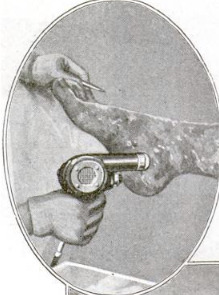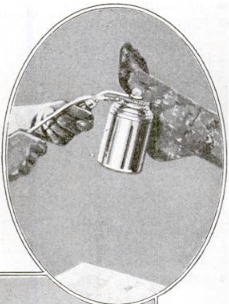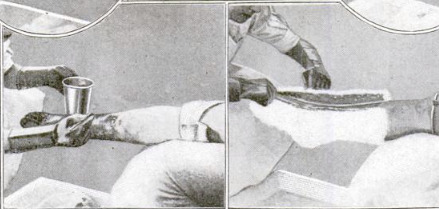A method of treating severe burns invented by a French doctor
Contenuto
-
Titolo
-
A method of treating severe burns invented by a French doctor
-
Article Title and/or Image Caption
-
Healing Burns without Pain and Disfiguring Scars
-
extracted text
-
REMEMBER the excruciating pain
which even a slight burn causes
you, and then try to imagine the
suffering resulting from a severe burn
by which a con-
siderable area of
skin is scorched
and destroyed.
Such severe
burns occur
sometimes in
factories, foun-
dries, and mines,
and are classed
among the most
serious injuries
to which workers
are exposed.
When the Ger-
mans introduced
“liquid fire” as
one of their
weapons of at-
tack during the
great war, the Allied sur-
geons in the field hospitals
found it difficult to cope
with the task of adequate-
ly treating burns. At that
critical moment Dr.
Barthe de Sandfort, a
retired French Navy sur-
geon, who had invented a
method of treating burns
by coating the scorched
surface with an air-tight
covering of medicated
paraffin wax, presented
his invention to the French
military authorities and
offered his services in administering,
the treatment and teaching others the
proper method of applying it. He was
given charge of a small hospital at|
Issy-les-Moulineaux, in Paris, to which
all soldiers suffering from burns were
sent for treatment. The results ob-
tained from this treatment were so
remarkable that it was adopted by
the hospital staffs of all the other
Allied armies.
The compound that Dr. Sandfort
employs for covering burned surfaces
consists of neutral paraffin, resins, and
certain disinfectants. It has a low
melting-point, and, when heated to
140° or 150° F.,
forms an amber-
colored liquid
which is either
brushed over the
surface of the
burn or sprayed
on. The hot
liquid hardens
quickly, and
forms a pliable
yet air-tight cov-
ering of the
burned area. A
thin layer of cot-
ton is placed on
the first coating
of wax, and is
made to adhere
to it by painting
it liberally with the melted
wax. For further protee-
tion the coated part is
swathed in cotton. After
the first twenty-four hours
the patient, in most cases,
is free from pain.
During the first stages
of the healing process the
injured tissues secrete a
large quantity of lymph,
which collects under the
shell of the dressing and
prevents it from adhering
to the tissues. The wax
Jdreeeing thay easily be
lifted or peeled off without causing the
slightest pain to the patient. The
burns should be dressed every twenty-
four hours for the first week or so.
-
Lingua
-
eng
-
Data di rilascio
-
1919-07
-
pagine
-
56
-
Diritti
-
Public domain (Google Books)
-
Archived by
-
Davide Donà
-
Marco Bortolami (editor)





